Drummer jokes [infographic]
The Science Behind A Tear-Jerker: Someone Like You
Why does Adele’s ‘Someone Like You’ make everyone cry? Science has found the formula
By MICHAELEEN DOUCLEFF
![[ADELEgraphic]](http://si.wsj.net/public/resources/images/RV-AF961A_ADELE_G_20120210234610.jpg)
The Wall Street Journal (illustration) Associated Press (photo); Universal Music Publishing (score)
On Sunday night, the British singer-songwriter Adele is swept the Grammys. Three of her six nominations are for her rollicking hit "Rolling in the Deep." But it’s her ballad "Someone Like You" that has risen to near-iconic status recently, due in large part to its uncanny power to elicit tears and chills from listeners. The song is so famously sob-inducing that "Saturday Night Live" recently ran a skit in which a group of co-workers play the tune so they can all have a good cry together.
What explains the magic of Adele’s song? Though personal experience and culture play into individual reactions, researchers have found that certain features of music are consistently associated with producing strong emotions in listeners. Combined with heartfelt lyrics and a powerhouse voice, these structures can send reward signals to our brains that rival any other pleasure.
Twenty years ago, the British psychologist John Sloboda conducted a simple experiment. He asked music lovers to identify passages of songs that reliably set off a physical reaction, such as tears or goose bumps. Participants identified 20 tear-triggering passages, and when Dr. Sloboda analyzed their properties, a trend emerged: 18 contained a musical device called an "appoggiatura."
An appoggiatura is a type of ornamental note that clashes with the melody just enough to create a dissonant sound. "This generates tension in the listener," said Martin Guhn, a psychologist at the University of British Columbia who co-wrote a 2007 study on the subject. "When the notes return to the anticipated melody, the tension resolves, and it feels good."
Chills often descend on listeners at these moments of resolution. When several appoggiaturas occur next to each other in a melody, it generates a cycle of tension and release. This provokes an even stronger reaction, and that is when the tears start to flow.
Read the rest here.
Music Review: Michael Jackson – Immortal
 I received Michael Jackson’s “Immortal” as a Christmas gift from one of the most talented musicians I know. I didn’t know what to expect when I first opened the CD. It’s impossible not to be impressed by his talent, rhythmic sensibility, and most of all, his flawless intonation. After listening to this collection, those opinions were confirmed. I was mesmerized from the first downbeat.
I received Michael Jackson’s “Immortal” as a Christmas gift from one of the most talented musicians I know. I didn’t know what to expect when I first opened the CD. It’s impossible not to be impressed by his talent, rhythmic sensibility, and most of all, his flawless intonation. After listening to this collection, those opinions were confirmed. I was mesmerized from the first downbeat.
The soundtrack to Cirque du Soleil’s celebration of Michael Jackson’s music is a twenty-track effort that takes the King Of Pop’s catalog and sanctions producer, Kevin Antunes, to chop up and piece back together to fit the show. In my opinion, this album doesn’t approach the sophistication of the remixing demonstrated by Cirque’s Beatle’s show, “Love”. It does, however, celebrate Jackson’s musical genius admirably.
The collection does a fine job drawing from the various eras of Michael’s career, from "The Jackson 5 Medley", featuring "I Want You Back", "ABC", and "The Love You Save", to the modern “King of Pop”. I found it hard not to smile as I listened to Michael’s grade school voice clearly cut through the densely orchestrated charts.
The album fuses lesser-known tracks like "Speechless" with bigger hits like "Human Nature", leaving the crisp bouncing of the twinkling synth intact. Disco laced rarities like "Workin’ Day And Night" and "This Place Hotel" feel at home with the thumping beat of "Wanna Be Startin’ Somethin’", though THE slightly more cluttered beat does not really add anything to the tune.
Some of the songs are condensed into shorter versions of themselves, with the occasional sound effects to enhance the choreography; such as the machine gun to close the otherwise effective, horn and metallic drum fueled remix of "Smooth Criminal". The sparse snaps that introduce "Thriller" would have made for a charming a cappela take on the song, but the storm of sound effects interferes with what could have been a fantastic retelling. At least they leave in Vincent Price’s creepy spoken word portion as the flickering funk of the guitar pulls in.
The slightly growling vocals of "Is It Scary", speaking of a book of darkness and mystery, give way to MJ’s trademark breathy beatboxing and piano-kissed orchestra swells pushing along the sinister hook before giving way to the clunky "Threatened", enhanced with a touch of Rockwell’s "Somebody’s Watching Me". A drippy electro-tinged synth muddies the waters of "You Are Not Alone" before transitioning to the string-laced, quivering vocals of "I Just Can’t Stop Loving You", where Antunes manages to sap the beauty out of one song before wisely using a more delicate touch with another on the same track. Titled “Immortal Megamix”, a new take on his solo hits makes for an eight-minute musical marathon on "Can You Feel It", "Don’t Stop ‘Til You Get Enough", "Billie Jean", and "Black And White", with DJ scratches and a dance beat anxiously assembled together with interesting chants of "Michael" droning through "Billie Jean".
For me, the musical payoff comes on the last track, “Man In The Mirror”. It doesn’t matter how many times I hear this, I am always inspired.
Ultimately, this is a well-intentioned celebration of Michael Jackson’s music. Undoubtedly, the audio/visual show will be exemplary, with context given to this musical mix. As a teaser for the Cirque show, this CD absolutely does the job!
The Cheesy World of Music Video Clichés
The World's Ugliest Music
Something John Cage would’ve appreciated—a pianist performs "the world’s ugliest music," which happens to be the world’s perfect submarine ping.
To see how that works—it has to do with mathematics, repetition, and what brains perceive as beautiful—check it out:
Spectacular Russian Opera and Ballet Theater

Novosibirsk State Academic Opera and Ballet Theatre is the largest and one of the most technically advanced theaters in Russia.
Its main floor features ticket offices and vestibule; on the second floor and the third floor there is a concert hall with adjoining ‘wings’ featuring rehearsal halls, administrative rooms, wardrobes and theater set departments.
The vestibule.


It was completed in February 1944, the first performance being held on May 12th, 1945. During these years, over 340 opera and ballet performances have been held here. Today, over 800 people work in the theater and about half of them are performers.
Construction works lasted for about 10 years, from 1931 till 1941. Some say that is was built by Germans but it’s not true. During WWII, a lot of exhibits from museums located in the European part of the USSR were kept here, including the Hermitage, Tretyakov Gallery and Bolshoi Theater.

The total area of the building is 11,837 m², the volume is 294,340 m³. The theatre is often called “Siberian Coliseum” for its size and beauty.
They spent over 33 million dollars on its renovation which ended in 2005. After that, its computerized stage equipment became the most technically advanced in Russia.

The concert hall.


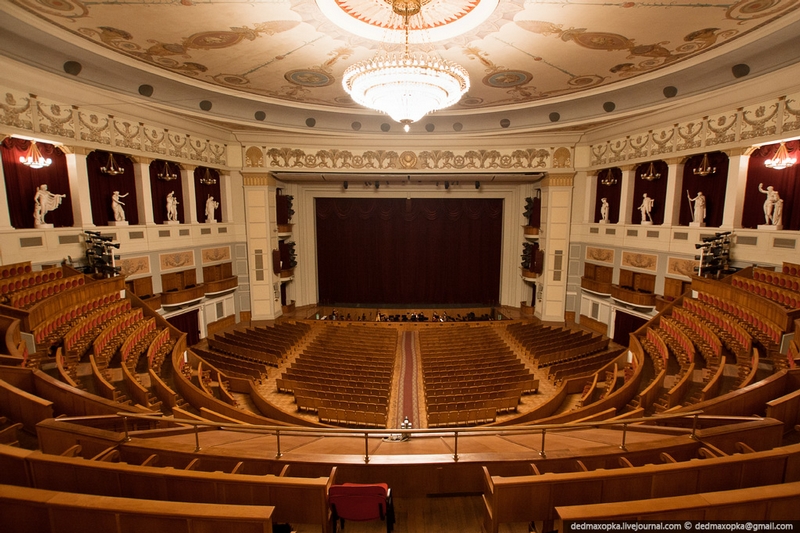
The grand hall.
After the reconstruction, they increased the number of seats in the grand hall to 1,774.



The filled the space between the columns of the upper gallery with 16 sculptures.

The ceiling of the grand hall is a kind of the acoustic screen made of pressed carton.

The chandelier is 6 meters in diameter and has a weight of over 2 tons.


This is a theater set for La Bayadère.

The view from the roof of the theater.

Compare it with this photo which was taken a year ago.

The principal construction of Novosibisk theatre’s building is the big dome, 60 metres wide and 35 metres high. The dome is a unique construction that supports itself without girders or columns. The ratio of its thickness (an average of 8 cm) to its radius is less than that of a chicken egg.


This photograph was taken from the top of a neighboring building.

Now, let’s check what happens backstage.

This is a large rehearsal hall for ballet dancers (there is also a small rehearsal hall in the theater).


Assembling the theater set for La Bayadère.
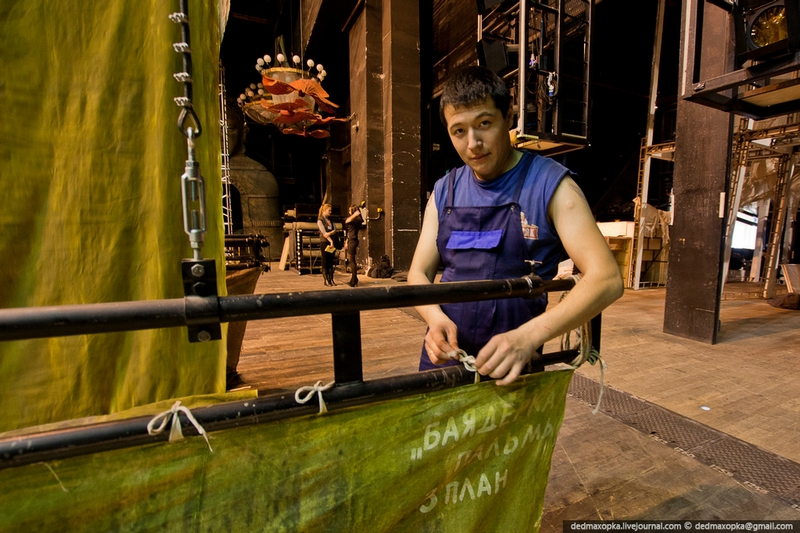
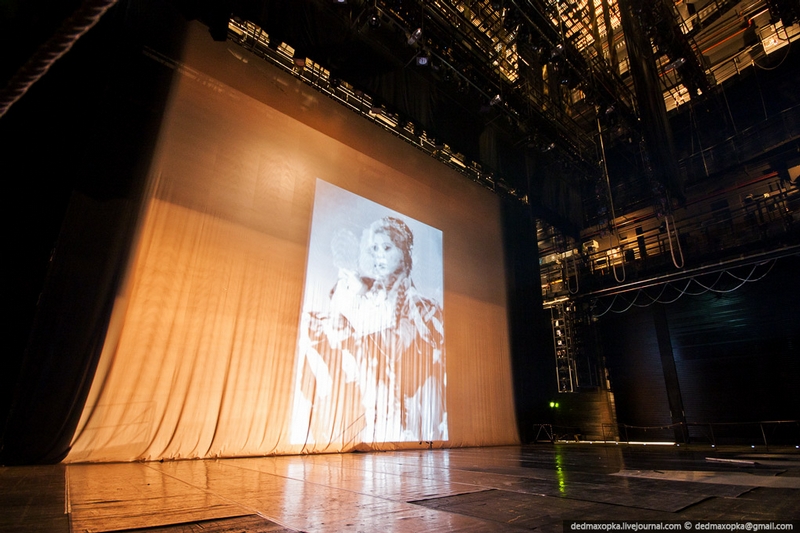

This stage is one of the largest in Eurasia.



We’ve got this high (27 meters above the ground) to see how this setting is fixed.


These electric motors are used to pull the setting up and down.
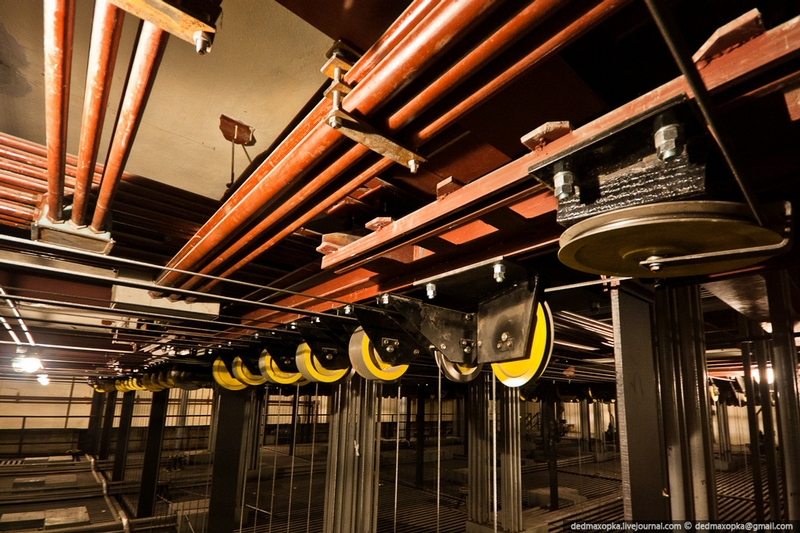

With this clock they synchronize the process of raising and lowering the theater setting.

Lift devices.

They control the setting from one of the balconies above the stage.


The orchestra pit.

Right now, they are carrying out a sound check.
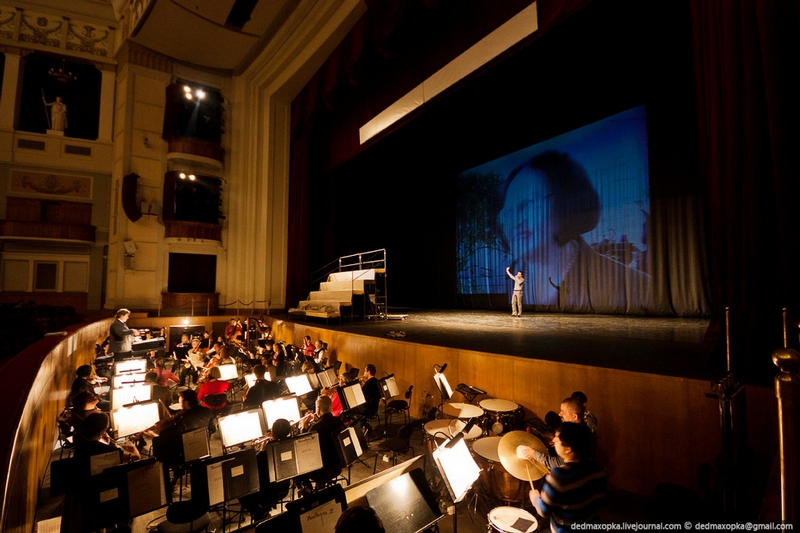
Karen Movsesyan is an opera singer and head of the theater’s PR department.

Behind the stage, they keep hard setting elements.




Here, they make costumes.

Each costume is made individually for each actor or ballet dancer.



Here they repair musical instruments.



Before another play. They always play to a full house!


Location: Novosibirsk
The Mahler Project: Setting The Stage
When a piece requires two orchestras and sixteen choirs to perform a piece, there’s far more to setting the stage than simply throwing up a few music stands and some extra chairs.
This time lapse video of Walt Disney Concert Hall being readied for a performance of Mahler’s Symphony no. 8 by the LA Philharmonic and the Simón Bolívar Symphony Orchestra of Venezuela should definitely appeal to the techies out there who never get the due they deserve once the curtain goes up.




